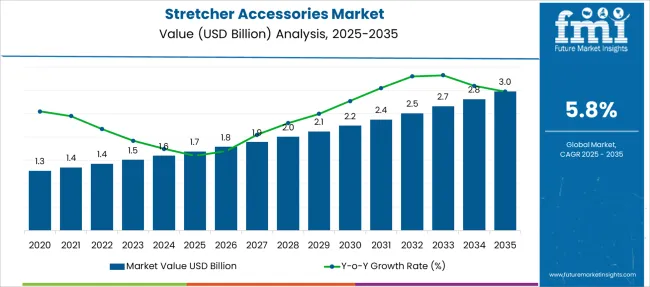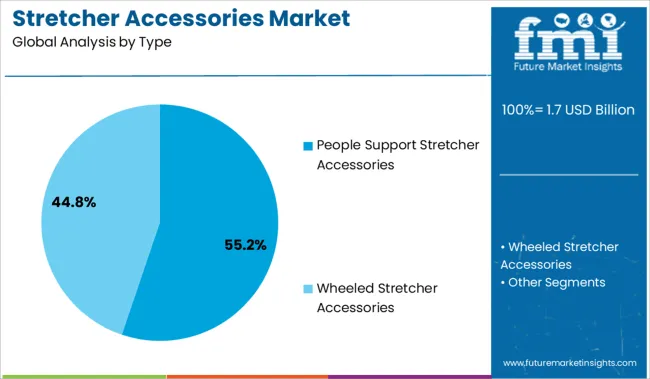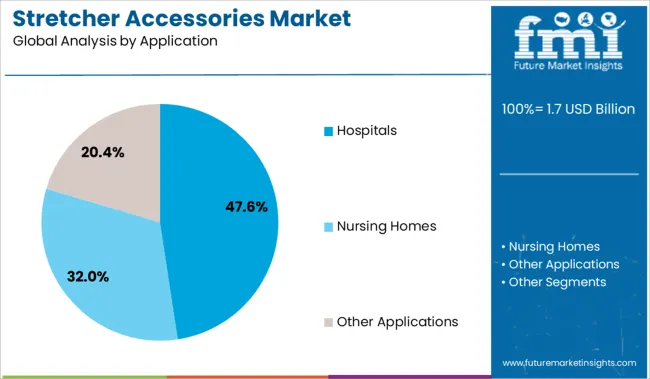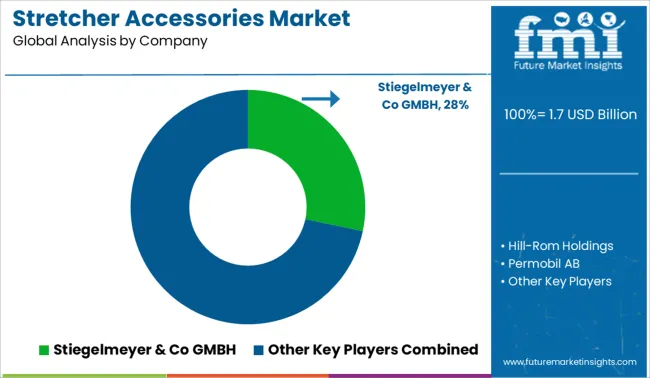The Stretcher Accessories Market is estimated to be valued at USD 1.7 billion in 2025 and is projected to reach USD 3.0 billion by 2035, registering a compound annual growth rate (CAGR) of 5.8% over the forecast period.

| Metric | Value |
|---|---|
| Stretcher Accessories Market Estimated Value in (2025 E) | USD 1.7 billion |
| Stretcher Accessories Market Forecast Value in (2035 F) | USD 3.0 billion |
| Forecast CAGR (2025 to 2035) | 5.8% |
The stretcher accessories market is witnessing consistent growth as global healthcare infrastructure expands and patient transport solutions become more specialized. Increased patient volumes in emergency and acute care settings are driving the need for efficient, adaptable, and ergonomic stretcher systems.
Hospitals and trauma centers are increasingly investing in advanced accessories that improve patient stability, comfort, and safety during intra and inter facility transfers. Additionally, the emphasis on caregiver ergonomics and infection control is encouraging the adoption of modular and easy to disinfect support equipment.
Technological enhancements in materials, portability, and multi use configurations are further supporting demand. As healthcare institutions focus on improving operational efficiency and patient outcomes, the demand for reliable stretcher accessories is expected to continue rising, particularly in urban and high traffic medical centers.
The market is segmented by Type and Application and region. By Type, the market is divided into People Support Stretcher Accessories and Wheeled Stretcher Accessories. In terms of Application, the market is classified into Hospitals, Nursing Homes, and Other Applications. Regionally, the market is classified into North America, Latin America, Western Europe, Eastern Europe, Balkan & Baltic Countries, Russia & Belarus, Central Asia, East Asia, South Asia & Pacific, and the Middle East & Africa.

The people support stretcher accessories segment is expected to represent 55.20% of the total market revenue by 2025 within the type category, making it the dominant segment. This growth is supported by increasing requirements for secure and comfortable patient handling during transport, especially in critical care and emergency scenarios.
These accessories include head supports, limb restraints, safety belts, and spinal immobilizers, all of which play a vital role in patient stabilization. The segment's popularity stems from its direct impact on patient safety, clinical efficiency, and transport reliability.
As emergency medical services and hospital transfer units prioritize patient safety and mobility, people support accessories continue to be integral to modern stretcher systems, reinforcing their leadership in the type segment.

The hospitals segment is projected to hold 47.60% of total revenue by 2025 within the application category, positioning it as the largest user segment. This dominance is driven by the high frequency of patient transport activities within hospital settings including emergency departments, operating rooms, and intensive care units.
Hospitals require stretcher accessories that meet stringent safety standards, offer quick deployment, and support diverse patient needs. The ability to streamline patient transfers while reducing risk of injury to both patients and medical staff has positioned these accessories as essential components of hospital logistics.
Ongoing infrastructure upgrades and rising hospital admissions are expected to further strengthen this segment’s presence in the stretcher accessories market.
Market Drivers
An increase in the prevalence of chronic diseases, like cancer, neurological disorders, etc., is expected to surge the demand for stretcher accessories during the forecast period.
Additionally, there have been various kinds of product innovations that have been shaping up the stretchers market as a whole. This can be seen in the form of introduction of medical equipment, like head immobilizer, toe clamp, etc. This as well might surge the sales of stretcher accessories during the forecast period.
One of the most important factors which is touted to have a positive influence on the stretcher accessories adoption trends is the increase in the number of accidents. Based on the statistics released by ILO, there are nearly 340 million occupational accidents each year. Such accidents have led to an increase in the number of disabilities worldwide, which might further surge the market share.
Furthermore, the current generation hospital bed accessories help in the customization of stretchers, which give a variety of options to the end users. For example, there are certain stretchers which are used in the hospitals that come with wheels for making transportation easier. On the other hand, there are stretchers which do not come with a wheel, and are carried by people.
Moreover, an increase in the geriatric population is also expected to surge the adoption of stretcher accessories. As people become older, even minor accidents can lead to certain kinds of complications. Moreover, a surge in the number of disabilities is also expected to surge the stretcher accessories market.
Market Restraints
One of the biggest challenges encountered by the market is the high cost associated with the stretchers. Additionally, owing to consistent technological innovations that are shaping up the healthcare sector, the current generation stretchers might not match the expectations. This as well might hamper the market growth going ahead.
Additionally, lack of awareness regarding the availability of stretchers and hospital beds in certain parts of the world is also expected to hamper the market growth. This is particularly seen in a lot of developing and underdeveloped nations.
As per the market research conducted by FMI, North America is currently the largest market. The availability of technologically advanced healthcare sector coupled with an increase in the geriatric population is driving the market growth. Apart from that, the high disposable income of people residing in this region makes such services affordable.

The main players in the stretcher accessories market are Stryker Corporation, Invacare Corporation, Invacare Corporation, ArjoHuntleigh (Getinge Group), Etac AB, Hill-Rom Holdings, Hill-Rom Holdings, Inc, Patterson Medical Holdings, Inc., Permobil AB, Stiegelmeyer & Co. GMBH, DJO Global and Sunrise Medical LLC.
The research report presents a comprehensive assessment of the market and contains thoughtful insights, facts, historical data, and statistically supported and industry-validated market data. It also contains projections using a suitable set of assumptions and methodologies.
The research report provides analysis and information according to market segments such as geographies, types and applications.
The global stretcher accessories market is estimated to be valued at USD 1.7 billion in 2025.
The market size for the stretcher accessories market is projected to reach USD 3.0 billion by 2035.
The stretcher accessories market is expected to grow at a 5.8% CAGR between 2025 and 2035.
The key product types in stretcher accessories market are people support stretcher accessories and wheeled stretcher accessories.
In terms of application, hospitals segment to command 47.6% share in the stretcher accessories market in 2025.






Full Research Suite comprises of:
Market outlook & trends analysis
Interviews & case studies
Strategic recommendations
Vendor profiles & capabilities analysis
5-year forecasts
8 regions and 60+ country-level data splits
Market segment data splits
12 months of continuous data updates
DELIVERED AS:
PDF EXCEL ONLINE
X-Ray Stretchers Market
Hospital Stretchers Market Size and Share Forecast Outlook 2025 to 2035
Car Accessories Market Size and Share Forecast Outlook 2025 to 2035
Bar Accessories Market
Jack Accessories Market Size and Share Forecast Outlook 2025 to 2035
Dock Accessories Market Size and Share Forecast Outlook 2025 to 2035
Golf Accessories Market Size and Share Forecast Outlook 2025 to 2035
Apple Accessories Market Report – Demand, Trends & Forecast 2025–2035
Cable Accessories Market Growth - Trends & Forecast 2025 to 2035
Laptop Accessories Market Size and Share Forecast Outlook 2025 to 2035
E-Bike Accessories Market Size and Share Forecast Outlook 2025 to 2035
Travel Accessories Market Analysis by Product Type, Material, Distribution Channel, End-User and Region 2025 to 2035
Key Players & Market Share in Laptop Accessories Market
Camera Accessories Market Trends - Growth & Forecast 2024 to 2034
Fashion Accessories Packaging Market Size and Share Forecast Outlook 2025 to 2035
Smoking Accessories Market Analysis – Growth & Forecast 2025 to 2035
Industry Share Analysis for Fashion Accessories Packaging Companies
Air Fryer Accessories Market Size and Share Forecast Outlook 2025 to 2035
Drinkware Accessories Market
Watercraft Accessories Market Growth - Trends & Forecast 2025 to 2035

Thank you!
You will receive an email from our Business Development Manager. Please be sure to check your SPAM/JUNK folder too.
Chat With
MaRIA